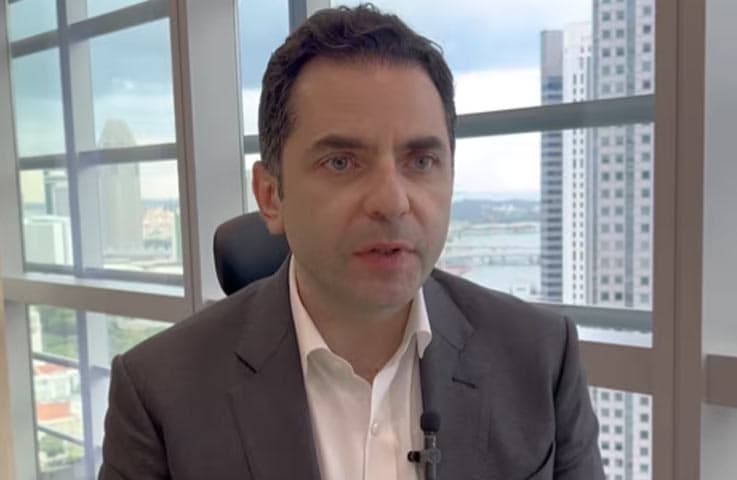Why Asia Investment Grade Bonds Are an Ally in Volatile Times

Omar Slim, CFA
Co-Head of Asia Fixed Income

Recurring bouts of volatility in bond markets caused by rising inflation and rate hikes could erode returns for investors as bond values fall. The pursuit of relative safety within the global fixed income universe may take investors beyond traditional benchmark allocations.
US dollar-denominated Asia investment grade (IG) bonds stand out for their track record of having lower volatility and better returns than US IG credit and emerging market (EM) bonds, making them an attractive diversifier in volatile markets. Risk-adjusted returns1 for Asia IG bonds have outperformed US IG credit, US inflation-linked bonds, and EM bonds over a five-year period.
Asia IG Bonds’ Risk/Return Profile Outshines US IG and EM Bonds
Five-Year Total Return History

Source: Bloomberg. Rolling 5-year data as of 31 March 2022. Commodities represented by the Bloomberg Commodity Index, Asia USD Bonds by the JPM JACI index, Asia IG USD Bonds by JPM JACI Investment Grade, Emerging Markets (USD) by the JPM EMBI Global Diversified index, US High Yield by Bloomberg Barclays US High Yield index, US Inflation Linked by Bloomberg Barclays US Inflation Linked index, US Equities by S&P 500 index, and Asia ex Japan Equities by the MSCI MXASJ index. Diversification does not insure against market loss. For illustrative purposes only. There is no assurance that the investment strategies and processes mentioned herein will be effective under all market conditions. Past performance, or any prediction, projection or forecast, is not indicative of future performance. *The Sharpe ratio indicates the reward per unit of risk by using standard deviation and excess return. The higher the ratio, the better the investment's historical risk-adjusted performance.
Asia IG’s lower volatility is also reflected in its maximum drawdown. For example, as yields rose on expectations of higher inflation leading to a tighter monetary environment, the maximum drawdown of Asia IG (-8.50%) from 30 July 2021 to 30 April 2022 is significantly lower than US IG (-13.23%).2 This differential is in line with US IG’s longer duration than Asia IG, which makes the former more sensitive to rising rates.3
We believe this competitive risk/return profile looks even more compelling considering how the market has been tested over this period, both by external shocks, such as the US-China trade dispute and monetary policy changes, and by regional events, including the recent troubles in China’s property sector. Annualized volatility for the asset class has remained comparatively subdued, and we believe the market’s characteristics continue to support this trend.
For one, Asia IG has a stable local institutional buyer base, which takes up a large part of the market’s new issues and tends to hold investments for the long term. This is partly due to investors’ familiarity with regional issuers. Asia’s vast savings pool offers the potential for this domestic investor base to remain robust into the future.
Asia-Based Buyers Anchor the IG Bond Market

Source: J.P. Morgan as of 31 March 2022.
Another factor supporting the market’s continued stability is the relative strength of the region’s economic fundamentals. Asian economies are expected to expand faster than advanced economies this year and next.4 The region’s central banks are closely watching imported inflation brought on by higher commodity prices. However, regional central banks are expected to take calibrated responses and have more room, in general, to deploy fiscal measures, if needed. China, for one, has signaled its intention to implement strong measures to boost economic activity.
From a corporate credit perspective, Asia IG issuers have entered the first quarter with steady or improving credit metrics, which provide potential cushion for any deterioration in the business outlook. We expect fallen-angel risk to remain subdued and idiosyncratic.
Asia IG Corporate Credit Metrics Are Healthy
EBITDA/Interest expense

Net Debt/EBITDA

Source: J.P. Morgan as of 31 March 2022.
With market uncertainty expected to persist for some time, Asia IG’s strong fundamentals and demonstrated risk-adjusted returns, as well as its stable investor base, may be hard to find elsewhere in the global bond markets. We believe a highly nuanced approach to credit selection can harness these advantages more effectively, starting with a robust credit research process that analyzes bonds from both the bottom up and top down to build a portfolio likely to meet the volatility and return challenges of shifting markets.
Footnotes
1 Risk-adjusted returns are measured using the Sharpe ratio. The ratio indicates the reward per unit of risk by using standard deviation and excess return. The higher the ratio, the better the investment's historical risk-adjusted performance. 2 J.P. Morgan, and Bloomberg, as of 30 April 2022. Indexes represented are the JACI IG and Bloomberg U.S. Corporate Investment Grade Bond Index. Maximum drawdown is the peak-to-trough decline during a specific recorded period of an investment. It measures the largest percentage drawdown that has occurred in a certain time period. 3 Bloomberg, PineBridge Investments as of 31 March 2022. Duration is a measure of the bond’s sensitivity to changes in interest rates. Yield refers to the rate of return if bonds are held to maturity. The rate of return includes the coupon payments received during the term of a bond and its principal repayment upon maturity. 4 International Monetary Fund as of April 2022.
Disclosure
Investing involves risk, including possible loss of principal. The information presented herein is for illustrative purposes only and should not be considered reflective of any particular security, strategy, or investment product. It represents a general assessment of the markets at a specific time and is not a guarantee of future performance results or market movement. This material does not constitute investment, financial, legal, tax, or other advice; investment research or a product of any research department; an offer to sell, or the solicitation of an offer to purchase any security or interest in a fund; or a recommendation for any investment product or strategy. PineBridge Investments is not soliciting or recommending any action based on information in this document. Any opinions, projections, or forward-looking statements expressed herein are solely those of the author, may differ from the views or opinions expressed by other areas of PineBridge Investments, and are only for general informational purposes as of the date indicated. Views may be based on third-party data that has not been independently verified. PineBridge Investments does not approve of or endorse any republication of this material. You are solely responsible for deciding whether any investment product or strategy is appropriate for you based upon your investment goals, financial situation and tolerance for risk.



